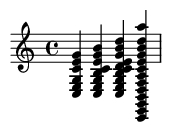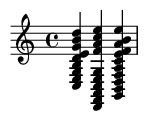Most musicians begin their journey by learning basic triads—the foundational building blocks of harmony. But to unlock the rich, complex sounds of jazz, R&B, and modern classical music, you need to explore the world of extended chords. These chords add new layers of color and emotional depth, transforming simple progressions into sophisticated harmonic statements.
This guide will demystify extended chords, taking you from basic theory to practical application. We'll cover how they're built, how to voice them effectively, and how to use them to elevate your own music.
What Are Extended Chords?
From Triads to Extensions: Stacking Thirds
At its core, traditional harmony is built by stacking intervals of a third. A major triad, like C major, consists of a root (C), a major third (E), and a perfect fifth (G). If we continue stacking thirds, we get seventh chords (C-E-G-B), and if we keep going, we enter the realm of extended chords.
The primary extensions are the 9th, 11th, and 13th. These notes are named for their interval distance from the root, though they function like a 2nd, 4th, and 6th, just an octave higher.
- 9th Chord: A seventh chord plus a third on top (Root-3-5-7-9).
- 11th Chord: A ninth chord plus another third (Root-3-5-7-9-11).
- 13th Chord: An eleventh chord plus one more third (Root-3-5-7-9-11-13).
Example: Building a Cmaj13 Chord
This example demonstrates how a C major triad evolves into a full Cmaj13 chord by stacking thirds.

The Art of Voicing: Beyond Stacked Thirds
While the "stacked thirds" approach is useful for understanding the theory, playing all seven notes of a 13th chord at once is often impractical and muddy-sounding. In practice, musicians use voicings—specific arrangements of the chord tones—to achieve a clear and musical sound. This usually involves two key principles:
- Omitting Notes: The root and the perfect fifth are the most commonly omitted notes, as they provide the least color. The bass player often covers the root, freeing up the pianist or guitarist to focus on the more colorful 3rd, 7th, and extensions.
- Avoiding Dissonance: In major and dominant chords, the natural 11th (a perfect fourth above the root) creates a harsh clash with the major 3rd. For this reason, the natural 11th is rarely used. Instead, musicians often use a sharpened 11th (#11), which creates a beautiful, dreamy sound. In minor chords, the natural 11th works perfectly.
Common Extended Chord Voicings
Here are some common, practical voicings for different extended chord qualities. Notice how they are spread out and omit certain notes for clarity.
Major, Minor, and Dominant Voicings
This example shows typical voicings for a Cmaj9, a Dm11, and a G13 chord.

Note: The G13 voicing omits the root (G) and the 5th (D), a very common practice in jazz. It contains the 3rd, 7th, 9th, and 13th.
Altered Extensions
To create even more tension and interest, especially on dominant chords, musicians use altered extensions. This involves lowering or raising the 9th, 11th, or 13th. Common alterations include the flat 9 (b9), sharp 9 (#9), sharp 11 (#11), and flat 13 (b13). These are staples of the modern jazz sound.
Extended Chords in Action: The ii-V-I Progression
One of the most common and powerful ways to see extended chords at work is in the ii-V-I progression, the cornerstone of jazz harmony. Using extended and altered chords in this context adds a compelling sense of tension and release.
Example: A ii-V-I in C Major
Listen to the harmonic movement from the mellow Dm9, to the tense G13(b9), resolving to the stable and beautiful Cmaj9.
Conclusion
Extended chords are more than just clusters of notes; they are expressive tools that can add sophistication, emotion, and character to your music. By understanding how they are built and, more importantly, how to voice them musically, you can begin to incorporate them into your playing, composing, and improvising. Start by experimenting with the voicings in this guide, listen for them in your favorite songs, and soon you'll be speaking a richer harmonic language.
